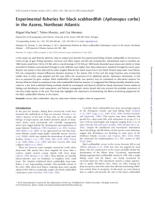Experimental fisheries for black scabbardfish (Aphanopus carbo) in the Azores, Northeast Atlantic. ICES Journal of Marine Science, 68(2), 302-308

In this study, we used fisheries observers' data to analyse and describe the experimental fishing of black scabbardfish in the Azores in terms of type of gear, fishing operation, catch per unit effort (cpue), and fish size compositions.
Standardized catch in numbers per 1000 hooks varied from 103 to 210 fish with an overall average of 132 fish per 1000 hooks. Recorded cpue values were similar to those recorded for Madeira and mainland Portugal in early 2000 but were higher than those observed in mainland Portugal for recent years. Bycatch was similar to that observed for other longline fisheries but much lower than in the North Atlantic deep-water trawl fishery. Fish size composition showed differences between locations in the Azores. Fish in Pico ans São Jorge / Graciosa were consistently smaller than in other areas sampled and this may reflect the occurence of an additional species, Aphanopus intermedius, in this area as proposed by gene analyses.
Black scabbardfish (of possibly two species) may be considered an alternative resource for Azorean fisheries. Based on experience from other scabbardfish fisheries, however, it is suggested that fishing mortality should be maintained at low level, traditional fishing methods should be encouraged, and bycatch should be closely monitored.
Future studies of biology and distribution, stock assessments, and fisheries management advice should take into account the probable occurence of two very similar species in the area. This study also highlights the importance of maintaining the fishery monitoring programme for the black scabbardfish fisheries in the Azores.







